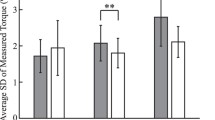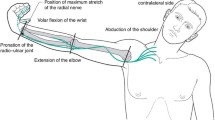Abstract
There are two key sources of information that can be used to match forces—the centrally generated sense of effort and afferent signals from mechanical receptors located in peripheral tissues. There is currently no consensus on which source of information is more important for matching forces. The corollary discharge hypothesis argues that subjects match forces using the centrally generated sense of effort. The purpose of this study was to investigate force matching at the shoulder before and after a suprascapular nerve block. The nerve block creates a sensory and muscle force mismatch between sides when matching loads. The torque matching accuracy did not change after the nerve block was administered. Directionally, the torque error was in the direction proposed by the corollary discharge hypothesis. However, the mismatch between deltoid EMG was substantially greater compared to the changes in the torque matching error after the block. The results support that sensory information is used during force matching tasks. However, since the nerve block also created a sensory disruption between sides, it is not clear how sensory information is reweighted following the nerve block and a role for sense of effort is still implicated.










Similar content being viewed by others
References
Adreani CM, Hill JM, Kaufman MP, Christine M, Hill JM, Marc P (1997) Responses of group III and IV muscle afferents to dynamic exercise. J Appl Physiol 82:1811–1817
Amann M (2013) Significance of group III and IV muscle afferents for the endurance exercising human. Clin Exp Pharmacol Physiol 39(9):831–835
Barbosa TC, Vianna LC, Fernandes IA, Prodel E, Rocha HNM, Garcia VP, Nobrega ACL (2016) Intrathecal fentanyl abolishes the exaggerated blood pressure response to cycling in hypertensive men. J Physiol 594(3):715–725
Brasil-Neto JP, Valls-Solé J, Pascual-Leone A, Cammarota A, Amassian VE, Cracco R, Cohen LG (1993) Rapid modulation of human cortical motor outputs following ischaemic nerve block. Brain J Neurol 116(Pt 3):511–525
Cafarelli E, Bigland-Ritchie B (1979) Sensation of static force in muscles of different length. Exp Neurol 65(3):511–525
Carson RG, Riek S, Shahbazpour N (2002) Central and peripheral mediation of human force sensation following eccentric or concentric contractions. J Physiol 539(Pt 3):913–925
Christensen MS, Lundbye-Jensen J, Geertsen SS, Petersen TH, Paulson OB, Nielsen JB (2007) Premotor cortex modulates somatosensory cortex during voluntary movements without proprioceptive feedback. Nat Neurosci 10(4):417–419
de Morree HM, De Klein C, Marcora SM (2012) Perception of effort reflects central motor command during movement execution. Psychophysiology 49:1242–1253
Gregory JE, Brockett CL, Morgan DL, Whitehead NP, Proske U (2002) Effect of eccentric muscle contractions on Golgi tendon organ responses to passive and active tension in the cat. J Physiol 538(Pt 1):209–218
Gregory JE, Morgan DL, Proske U (2004) Responses of muscle spindles following a series of eccentric contractions. Exp Brain Res 157(2):234–240
Jones L, Hunter IW (1983) Effect of fatigue on force sensation. Exp Neurol 81:640–650
Jones L, Piateski E (2006) Contribution of tactile feedback from the hand to the perception of force. Exp Brain Res 168:298–302
Lafargue G, Paillard J, Lamarre Y, Sirigu A (2003) Production and perception of grip force without proprioception: Is there a sense of effort in deafferented subjects? Eur J Neurosci 17(12):2741–2749
Luu BL, Day BL, Cole JD, Fitzpatrick RC (2011) The fusimotor and reafferent origin of the sense of force and weight. J Physiol 589(Pt 13):3135–3147
Mangalam M, Conners JD, Singh T (2018) Muscular effort differentially mediates perception of heaviness and length via dynamic touch. Exp Brain Res 237:237–246
McCloskey D, Ebeling P, Goodwin GM (1974) Estimation of weights and tensions and apparent involvement of a “sense of effort”. Exp Neurol 42(1):220–232
McCloskey D, Gandevia S, Potter E, Colebatch J (1983) Muscle sense and effort: motor commands and judgements about muscular contractions. Adv Neurol 39:151–167
McCully SP, Suprak DN, Kosek P, Karduna AR (2007) Suprascapular nerve block results in a compensatory increase in deltoid muscle activity. J Biomech 40(8):1839–1846
Monjo F, Shemmell J, Forestier N (2018) The sensory origin of the sense of effort is context-dependent. Exp Brain Res 236:1997–2008
Monzee J, Yves L, Smith A (2003) The effects of digital anesthesia on force control using a precision grip. J Neurophysiol 89:672–683
Proske U, Allen T (2019) The neural basis of the senses of effort, force and heaviness. Exp Brain Res 1:1–11
Proske U, Gregory JE, Morgan DL, Percival P, Weerakkody NS, Canny BJ (2004) Force matching errors following eccentric exercise. Hum Mov Sci 23(3–4 SPE. ISS.):365–378
Riemann BL, Lephart SM (2002) The sensorimotor system, part I: The physiologic basis of functional joint stability. J Athletic Train 37(1):71–79
Sanes JN, Shadmehr R (1995) Sense of muscular effort and somesthetic afferent information in humans. Can J Physiol Pharmacol 73(2):223–233
Smith SA, Querry RG, Fadel PJ, Gallagher KM, Strømstad M, Ide K, Secher NH (2003) Partial blockade of skeletal muscle somatosensory afferents attenuates baroreflex resetting during exercise in humans. J Physiol 551(3):1013–1021
Toma S, Lacquaniti F (2016) Mapping muscles activation to force perception during unloading. PLoS One 11(3):1–28
Tucker R (2009) The anticipatory regulation of performance: The physiological basis for pacing strategies and the development of a perception-based model for exercise performance. Br J Sports Med 43(6):392–400
Waddell ML, Amazeen EL (2017) Evaluating the contributions of muscle activity and joint kinematics to weight perception across multiple joints. Exp Brain Res 235(8):2437–2448
Waddell ML, Fine JM, Likens AD, Amazeen EL, Amazeen PG (2016) Perceived heaviness in the context of newton’s second law: combined effects of muscle activity and lifting kinematics. J Exp Psychol Hum Percept Perform 42(3):363–374
Zenon A, Sidibe M, Olivier E (2015) Disrupting the supplementary motor area makes physical effort appear less effortful. J Neurosci 35(23):8737–8744
Funding
Research reported in this publication was partially supported by the National Institute of Arthritis and Musculoskeletal and Skin Diseases (NIAMS) of the National Institutes of Health (NIH) under award number 5R01AR063713.
Author information
Authors and Affiliations
Corresponding author
Ethics declarations
Conflict of interest
The authors have no conflicts of interest to disclose.
Additional information
Publisher's Note
Springer Nature remains neutral with regard to jurisdictional claims in published maps and institutional affiliations.
Rights and permissions
About this article
Cite this article
Phillips, D., Kosek, P. & Karduna, A. Force perception at the shoulder after a unilateral suprascapular nerve block. Exp Brain Res 237, 1581–1591 (2019). https://doi.org/10.1007/s00221-019-05530-1
Received:
Accepted:
Published:
Issue Date:
DOI: https://doi.org/10.1007/s00221-019-05530-1




